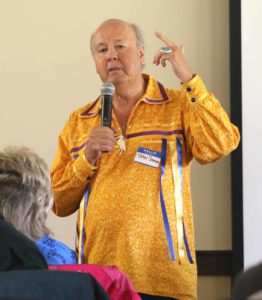Debate: Was Clinton
Expedition Genocide?
By JIM KEVLIN • Special to www.AllOTSEGO.com-

JOHNSTOWN – The lead-off speaker, Glenn F. Williams, author of “Year of the Hangman: George Washington’s Campaign Against the Iroquois,” had one take.
“Washington’s idea was always assimilation, not genocide,” he told 80 historians, researchers and students Saturday, Nov. 2, at the “Sullivan-Clinton Campaign Symposium,” organized by the Fort Plain Museum at Fulton-Montgomery Community College.
But G. Peter Jemison, manager of the Ganondagan State Historic Site, near Canandaigua, had another take: George Washington – “he was a racist; he owned slaves” – should be tried for war crimes.
He recounted several episodes to underscore his point, ending up with Iroquois refugees who fled to huddle under the shelter of Fort Niagara that winter of 1779. Several hundred died.
“If that isn’t genocide, I don’t know what genocide is,” he said.
According to Brian Mack, the museum trustee who organized the symposium, Jemison’s perspective was new to the Fort Plain Museum’s programming, which includes its annual “American Revolution Mohawk Valley Conference” each June.
Last spring, he said, the American History Roundtable had planned a discussion at Siena College, outside Albany, featuring Robert E. Mulligan Jr., CGP graduate and a curator of military history for a quarter-century at the New York State Museum in Albany.
According to Mack, an activist, Michelle Schenandoah, protested the lack of a Native American perspective, and Siena cancelled the roundtable session, entitled “Supplying the Sullivan Expedition into Iroquois Country, 1779.” (A Siena spokesperson said it was the roundtable, not the college, that decided not to hold the forum.)
“After reading about (it), I was really quite shocked to see such an event is taking place, and further, on the Siena campus,” Schenandoah, a Siena alumna, said in an email to Kathleen Kiernan, executive secretary to President Ed Coughlin, (who passed away over the summer.)
“This military campaign … was an act of genocide against my peoples. Our nations are still recovering from the long-term impacts from this war that resulted in the loss of lives, the separation of our Confederacy, land loss and intergenerational traumas resulting from this devastation,” wrote Schenandoah, who provided a copy of the email to this newspaper.
That dust-up, said Mack, caused the Fort Plain Museum to seek out Jemison for this program. He is also a descendant of Mary Jemison, whose “Narrative” (1824) of her capture at age 12 and assimilation into the Shawnee and Seneca tribes is considered a classic of the “captivity narrative” genre; located as an adult, she elected to stay with her Seneca family in western New York.
In addition to Glenn Williams, who discussed the Battle of Newtown (near Elmira) and other military encounters, and Mulligan, who explored the difficulty of supplying an Army in a wilderness, the program included William A. Starna, the SUNY Oneonta professor emeritus of anthropology, who focused on Clinton’s Dam, which he said was probably built near today’s Main Street bridge.
But he ended with a short discussion of genocide, noting the word is of recent vintage, coming into general use after the 1948 U.N. Conference on Genocide, following World War II found motive, intent and outcome must be considered in determining if genocide has occurred.
Applying the term to the Sullivan-Clinton Expedition – Gen. James Clinton’s brigade came through Cooperstown and down the Susquehanna and destroyed the Indian village at Onaquaga before joining Sullivan at Tioga Point – is “factually flawed,” Starna said.
Washington’s orders, contained in a May 1779 letter to Clinton, “fell well short of eradication and elimination of a whole people,” he told the gathering.
Participants at several points mentioned parts of Washington’s orders to Clinton, calling for “total destruction of their villages and the capture of as many persons of every age and sex as possible … Ruin their crops now in the ground and prevent their planting more … When we have effectively chastised them, we may then listen to peace and endeavor to draw further advantage of their fears.”
While aggressive, the orders were to destroy land and crops, not people, they said. Even Jemison characterized the expedition as “a war on vegetables.”
Williams also questioned Jemison’s conclusions. In his presentation, he noted that the British, after the Revolution broke out, sought out the Iroquois as allies and – given longstanding good relations with Sir William Johnson, the Colonial governor – had some success.
However, two of the Six Nations’ tribes – the Oneida and Tuscarora – allied with the Americans, even in the Sullivan-Clinton Expedition. The other four – Mohawk, Cayuga, Onondaga and Oneida – “chose the wrong side to support,” he said in an interview after Jemison’s talk, “and there were consequences of that.”


If no crime record, this year 2021, can budget of Indians be honored to return to vegetables instead of expensive handouts?
Counties cannot tax the peaceful while growing organically, Indians have farmed longer than any other group in those 40 villages ruined by Sullivan, the Fort Pitt attacks to Indian villages, and Governor Clinton’s brothers destruction.